6 Books on Thought Leadership You Should Read
![]()
To lead means you expose yourself on the front lines. No hiding.
Launching a trade nonfiction book is one of the most powerful ways to lead. And one of the most nerve-wracking. And one of the most rewarding for you and your audience.
I devour and break down some 40 or so trade nonfiction books a year in business, creativity, innovation, design, psychology, writing, publishing, and science. Another dozen books or so of fiction. A handful of books of essays and poetry a year.
I do so to keep myself nimble and to aid our clients in shaping the best books, brands, and offers possible.
By request, I’m reviewing here 6 of the top thought leadership books I’ve read recently that have come across my desk. These are 6 books I think give Tracking Wonder’s audience the most value to do what we help you do. They can help you master your work flow & creative cycle and own your place in the world as a thought leader, conversation leader, and business artist.
To lead with thoughtfulness
I’ve reviewed numerous definitions of “thought leadership” during the past few years. Malcolm Gooderham’s three criteria at The Holmes Report have the most weight in my view:
Thought leadership is:
- Strategic not tactical.
- In the DNA of the business, not outsourced to one person or department.
- The organizing principle of the business and the defining proposition.
Gooderham is head of thought leadership at FTI Consulting’s Strategic Communications division. He homes in on a central ingredient of thought leadership: integrity.
Thought leadership doesn’t come from one clever article or campaign or offer or tactic. It comes from consistency and organically fits the founder’s, CEO’s, or organization’s core way of operating and engaging.
It can’t be faked.
To be a thought leader means you put your ideas within your field or industry on the front line. You own your message and medicine. You not only change the way others think and act and make. You also change the way people within your own field play.
People look to what you’re saying and making + how you’re saying and making it.
It’s no wonder, then, that many people and businesses cower at the prospect of owning their ideas and their own point of view publicly. Fear of looking foolish or appearing full of hubris often makes the best minds of our time hide out.
May these six books help you emerge and expand your presence and positive influence.
6 Books on Thought Leadership
1. Stand Out: How to Find Your Breakthrough Idea and Build a Following Around It. By Dorie Clark. Portfolio Penguin (2015)
Dorie Clark’s book Stand Out starts from the provocative premise that if you want people to recognize the value of your own ideas, you have to work at getting your ideas to stand out. Her premise is right in line with one of Tracking Wonder’s 12 Principles for Doing Business as Unusual – Own Your Message – And Stand Up for It.
Dorie is a former presidential campaign spokeswoman and is adjunct professor of business administration at Duke University’s Fuqua School of Business.
Signature Thought Style and Structure: This elegant book – both thoughtful and practical – offers chapters on defining your idea, networking, and building community. Each chapter includes real-case studies that you will not find in typical entrepreneur books, and it includes ASK YOURSELF sections with reflective questions for you to consider.
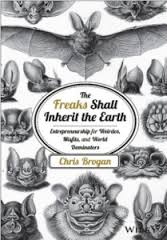
2. The Freaks Shall Inherit the Earth: Entrepreneurship for Weirdos, Misfits, and World Dominators.
By Chris Brogan. Wiley Books (2014)
The Freaks Shall Inherit the Earth is a smart book by a disarmingly endearing guy. Chris Brogan has a way of sounding unassuming and down-to-earth, and yet he has his finger on the pulse of what’s happening in entrepreneurship. Here’s how the successful serial entrepreneur known for social media wizardry, human-centered business, and small business ownership frames our current situation:
The freaks already have inherited the earth, my friend. Weirdos and misfits are now the world dominators. It used to be that all the crazy fringe interests of the world were absolutely underground. Now, the underground has become the core of a thriving and somewhat hard-to-track new economy.
The premise is simple but provocative: If you don’t fit into business as usual, you can realize your dreams. Rich with examples and stories, Brogan also offers ample actionable advice as well as Tracking Wonder-style frameworks in chapters such as “Fall in Love with Not Knowing.”
Signature Thought Leader Style and Structure: Brogan grew up playing Dungeons & Dragons and reading comic books. He loves superheroes. Fitting then that he opens with a reference to Marvel’s recent risky film venture and closes with a chapter called “Take Action! Fight Crime! Save the World!” His friendly Irish wit infuses these pages. 16 short chapters at under 200 pages makes the book easily digestible.
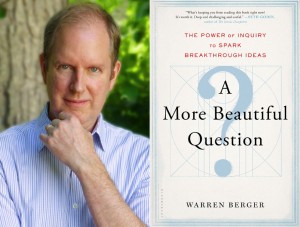
3. A More Beautiful Question: The Power of Inquiry to Spark Breakthrough Ideas.
By Warren Berger. (Bloomsbury: New York 2014)
Warren Berger’s book A More Beautiful Question has Tracking Wonder written all over it. And I’ve written all over my copy. To live in a hut of questions instead of an ivory tower of answers is one of our mottoes, and Berger helps us build that hut beautifully.
Berger is a journalist who tracks entrepreneurs, creatives, scientists – our gambit of people.
The introduction lays out the prevailing problem and creative tension: We know that the art of questioning resides at the heart of science and intellectual and creative discovery. Yet businesses and educational institutions under-value it. Why?
Simple: Questioning cedes power. Questioning invites uncertainty. In Berger’s words,
questions challenge authority and disrupt established structures, processes, and systems, forcing people to have to at least think about doing something differently.
In this sense, business artists are right up there with poets and intellectuals for being dangerous. Wisely, Berger does not title his book A More Dangerous Question.
His provocative premise is elegant: Learning to frame and ask a beautiful question can catalyze the change you want.
He subjectively defines a beautiful question this way:
A beautiful question is an ambitious yet actionable question that can begin to shift the way we perceive or think about something – and that might serve as a catalyst to bring about change.
Although I savor playful questions of the Pablo Neruda Book of Questions to awaken creative framing, I favor Berger’s bias toward action and influence here. Berger’s definition puts the quest in questions.
His book fulfills its promise.
Signature Thought Leader Style and Structure: A More Beautiful Question’s form matches its content and its creator’s persona. Each chapter poses a set of 5 to 8 questions that, in artful sequence, unfold the chapter’s content. The first question for chapter one “The Power of Inquiry,” for instance, is “If they can put a man on the moon, why can’t they make a decent foot?” and ends with the question, “How do you move from asking to action?”
Editor’s Note: The book’s artful structure benefits from Bloomsbury editor George Gibson’s touch. As Berger acknowledges, Gibson regards himself as an “activist editor,” a title in the Maxwell Perkins tradition I like. Berger shapes a trail of questions that leads us into the rich thicket of questions.
With applications in business and in life, A More Beautiful Question is required reading for any business artist who aspires to do business not as usual but as art.
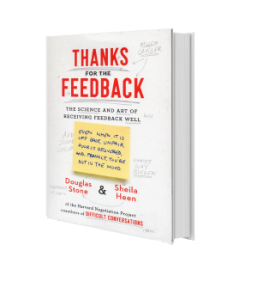
4. Thanks for the Feedback: The Science and the Art of Receiving Feedback Well (Even when it is off base, unfair, poorly delivered, and, frankly, you’re not in the mood). By Douglas Stone & Sheila Heen. (Viking Penguin: New York 2014)
I wish I had Thanks for the Feedback 30 years ago. That’s how long I’ve been in the business of giving and receiving feedback, encouragement, and critique.
Stone and Heen are lecturers on law at Harvard Law School. They work with the Harvard Negotiation Project whose aim is to improve the practice and theory of conflict resolution.
The authors set up the provocative premise clearly: Learning the art of receiving feedback (“pull”) is more effective than learning the art of giving feedback (“push”).
They speak Tracking Wonder’s language of mastery of skills. They speak specifically of learning to create “pull”:
Creating pull is about mastering the skills required to drive our own learning; it’s about how to recognize and manager our resistance, how to engage in feedback conversations with confidence and curiosity, and even when the feedback seems wrong, how to find insight that might help us grow.
And here’s the clincher that echoes one of our messages at Tracking Wonder:
It’s also about how to stand up for who we are and how we see the world, and ask for what we need.
That last part has become startlingly clear to me in the past two years: Many of us simply are inadequately equipped to ask for what we need. This book helps equip you.
Stone and Heen go on:
We like the word “pull” because it highlights a truth often ignored: that the key variable in your growth is not your teacher or your supervisor. It’s you.
The book’s promise is clear:
[O]ur primary purpose is to take an honest look at why receiving feedback is hard, and to provide a framework and some tools that can help you metabolize challenging, even crazy-making information and use it to fuel insight and growth.
They deliver that promise.
Structure: The first main section examines three kinds of triggers that get in our way of receiving feedback effectively: truth triggers, relationship triggers, and identity triggers. The next section “Feedback in Conversation” lays out practical steps to receive feedback effectively in conversations and organizations.
I’ve referred three separate groups – one of authors, of entrepreneurs, and of creatives – to this book within the past month. We have included for years forums of guided pack-sourcing in our programs and services. This book, though, is refining what we do and how I not only give feedback – but also how I/we receive it.
If you are a team leader, manager, or business artist who relies on optimal relationships in order to execute your ideas, read this book. You may learn more than you anticipated about yourself. It’s worth it.
Follow Stone and Heen here to learn more about receiving feedback with curiosity and grace as you lead.
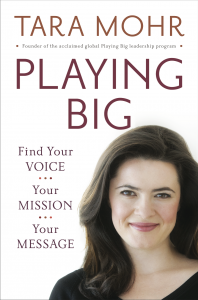
6. Playing Big: Find Your Voice, Your Mission, Your Message. By Tara Mohr. (Gotham Books – Penguin: New York 2014)
With the first four books above in your tool belt, you’re ready for Tara Mohr’s Playing Big. Aimed at women entrepreneurs, there’s value for any entrepreneur or aspiring thought leader who undervalues her or his potential message and medicine.
Mohr’s prevailing problem and opening tension are clear: Brilliant women are playing small. The kinds of outward-centered tactics and tips they’re given are not helping them. They don’t help because women do not have a clear internal compass to make choices and take action from – what I will say is – a place of integrity.
Mohr’s provocative premise is that women require a set of frameworks and tools to view themselves differently and to discern the advice and tips they receive.
That move from the inside-out is crucial for business artists.
The word “big” admittedly triggers me, but Mohr releases that trigger on the first page:
Playing Big…is not about the old-school notion of playing big – more money, more prestigious title, bigger empire, or fame. It’s about you living with a sense of greater freedom to express your voice and pursue your aspirations….
This playing big is not above climbing the ladder within dysfunctional systems. It’s about learning how to use your voice to change those systems.
In that respect, Mohr’s new school way of playing big is indeed about doing business as unusual.
Like everyone on this list, Mohr lives her message. She has played big with integrity. She has put herself on national tv and then shared with her pack how she converted her insecurities into power. Her capacity to leverage her presence without buzz has helped her harness a loyal, raving audience.
Mohr delivers on her promise by offering clear guidance on fear, the inner critic, the inner mentor, and “unhooking from praise and criticism” – a useful complement to Stone and Heen’s book.
Signature Thought Leader Style and Structure: Mohr has a welcoming, warm voice as the compassionate coach and leader that she is. She is an innovative thinker with a quiet style. So it’s fitting that she challenges outward authoritative sources for advice. Mohr brings her spiritual outlook and Jewish background to bear in the chapter on fear in which she describes and applies the Hebrew concepts of pachad and yirah. Pachad is fear that stems from self-doubt. Yirah is fear that stems from expansion and expansiveness. It’s the holy cr$p of awe.
With 10 substantial chapters replete with actionable exercises, this book is recommended reading for any business artist or thought leader still questioning her voice and talent and potential impact in not-so-beautiful ways.
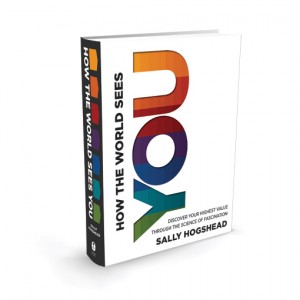
6. How the World Sees You: Discover Your Highest Value Through the Science of Fascination. By Sally Hogshead. (Harper Business 2014)
In This World of Buzz, you cannot afford not to stand out. But how can you do so with integrity and skill? Sally Hogshead, a smart creative mind and consultant, answers that question with provocative premises of her own in her new book How the World Sees You – WSJ #1 Bestseller & NYT #2 Bestseller.
Namely, you need to fascinate. But you need to fascinate in only the way that you can fascinate. We’re not talking about charisma or making noise. Introverts and subtle communicators who blush about branding have plenty of room to prosper in Hogshead’s schemata.
Hogshead knows about fascination – a sparkly cousin to quieter wonder. She got her professional start by writing copy for brands such as BMW. That heritage helped her appreciate creative language’s power to influence perception and helped her hone her own skills.
Hogshead’s book How the World Sees You lays out her provocative premises:
- Leverage your highest distinct value more than your technical knowledge.
- Leverage your distinctions more than your strengths.
- Leverage your distinct fascinating personality to avoid the three nemeses – distraction, competition, and commodification.
The How to Fascinate system revolves around what Hogshead calls the seven advantages – specific ways to communicate your highest distinct value successfully. Here are the seven advantages:
INNOVATION – You change the game with creativity
PASSION – You connect with emotion
POWER – You lead with command
PRESTIGE – You earn respect with high standards
TRUST – You build loyalty with consistency
MYSTIQUE – You communicate with substance
ALERT – You prevent problems with care
Each of us, according to Hogshead’s approach and assessment, has a primary advantage and a secondary advantage. When you combine your primary advantage and your secondary advantage, you discover your personality archetype.
For instance, my Archetype is PRESTIGE + INNOVATION = The Avant-Garde (Original * Enterprising * Forward-Thinking).
Several of our creative entrepreneur clients are MYSTIQUE + INNOVATION = The Secret Weapon (Nimble * Unassuming * Independent). Others are PASSION + INNOVATION = The Catalyst (Out-of-the-Box * Social * Energizing). Hogshead herself is a Catalyst.
Others of our business artist clients are PASSION + POWER = The People’s Champion (Dynamic * Inclusive * Engaging) as well as POWER + TRUST = The Guardian (Prominent * Genuine * Sure-Footed).
Once you appreciate how you distinctly add value to your audiences and to what we call your patch of the planet, then a couple of profound shifts happen. You stop trying to be like someone else.
And you stop competing by trying to be better.
Instead, you start being more of the best of you.
When you do so and you do so well, then you can earn your highest earning potential.
Yes, I am wildly biased in championing this book because we have proof of its methods’ applicable effectiveness.
The last section includes Hogshead’s latest iteration – the Anthem Method, a way to create your tagline based on your Personality Archetype.
Signature Style: Hogshead is funny. With a last name like that, you’d better be. Her wit and honesty make this book highly
readable, valuable, and authentic. She writes like a Catalyst.
Disclosures: Everyone on our team takes the Fascinate Assessment. Many clients and people in some of our Business ArtMark Academy programs take the assessment as well. We have used these assessments to great success both for our own business as well as for helping authors own their own voice and message, pitch books & services, and shape their branding Story.
If you’re a business artist who wants to own your message with integrity and become a thought leader or conversation leader in your field, then put this book at the top of your list.
Publishing solid content remains the most effective way to build their visibility as well as to engage and acquire clients. They know that publishing consistent content helps them make a difference in people’s lives and minds. Join our writing community at The Writing Den. The Writing Den is an action-oriented online community and content incubator for content creators, thought & conversation leaders, bloggers, writers, and others dedicated to shipping their best work out to the world. We open our doors for registration once a year, sign up to be notified when registration opens in July.